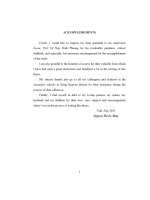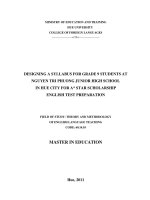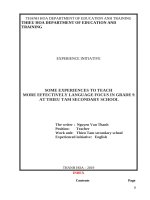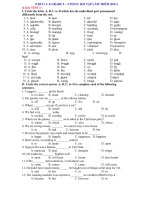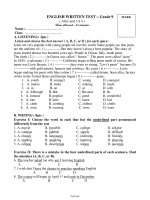PASCAL CONTEST GRADE 9 SOLUTIONS
Bạn đang xem bản rút gọn của tài liệu. Xem và tải ngay bản đầy đủ của tài liệu tại đây (1.29 MB, 12 trang )
<span class="text_page_counter">Trang 1</span><div class="page_container" data-page="1">
in MATHEMATICS and COMPUTINGcemc.uwaterloo.ca
</div><span class="text_page_counter">Trang 2</span><div class="page_container" data-page="2">1. Evaluating, <sup>20 + 22</sup>
422 <sup>= 21.</sup>
12 <sup>= 2.</sup>
Answer: (E)
4. On a number line, −3.4 is between −4 and −3.
This means that −3.4 is closer to −4 and −3 than to any of 0, 3 or 4, and so the answer mustbe −4 or −3.
If we start at −3 and move in the negative direction (that is, to the left), we reach −3.4 aftermoving 0.4 units.
It then takes an additional 0.6 units to move in the negative direction from −3.4 to −4.Therefore, −3.4 is closer to −3 than to −4, and so the answer is (B) or −3.
Alternatively, when comparing −3, −4 and −3.4, we could note that −3.4 is between −3.5 and−3 and so is closer to −3:
–4 –3.5 –3–3.4
Answer: (B)
5. From the diagram, P R = 10 − 3 = 7 and QS = 17 − 5 = 12 and so P R : QS = 7 : 12.
Answer: (A)
6. Between them, Robyn and Sasha have 4 + 14 = 18 tasks to do.
If each does the same number of tasks, each must do 18 ÷ 2 = 9 tasks.This means that Robyn must do 9 − 4 = 5 of Sasha’s tasks.
Answer: (C)
7. Because all of the angles in the figure are right angles, each line segment is either horizontal orvertical.
The height of the figure is 3x and the width of the figure is 2x.
This means that the length of the unmarked vertical segment must equal 3x − x = 2x.Also, the length of the unmarked horizontal segment must equal 2x − x = x.
Starting in the top left corner and adding lengths in a clockwise direction, the perimeter isx + 2x + x + x + 2x + 3x = 10x.
</div><span class="text_page_counter">Trang 3</span><div class="page_container" data-page="3">Alternatively, we can “complete the rectangle” by sliding the shortest horizontal side and theshortest vertical side as shown to form a rectangle with height 3x and width 2x:
8. The total central angle in a circle is 360<sup>◦</sup>.
Since the Green section has an angle at the centre of the circle of 90<sup>◦</sup>, this section correspondsto <small>90</small><sup>◦</sup>
There is 1 route from M to each of C and B: M → C and M → B.There are 3 routes to D: M → D and M → C → D and M → B → D.This means that there are 4 routes to F :
</div><span class="text_page_counter">Trang 4</span><div class="page_container" data-page="4">11. Since the given grid is 6 × 6, the size of each of the small squares is 1 × 1.This means that QR = P S = 3.
The additional integers between 1 and 100 that have a tens digits equal to 6 are60, 61, 62, 63, 64, 65, 67, 68, 69
of which there are 9. (Note that 66 was included in the first list and not in the second list sincewe are counting integers rather than total number of 6s).
Since the digit 6 must occur as either the ones digit or the tens digit, there are 10 + 9 = 19integers between 1 and 100 with at least 1 digit equal to 6.
Answer: (C)
13. Suppose that Rosie runs x metres from the time that they start running until the time thatthey meet.
Since Mayar runs twice as fast as Rosie, then Mayar runs 2x metres in this time.
When Mayar and Rosie meet, they will have run a total of 90 m, since between the two ofthem, they have covered the full 90 m.
Therefore, 2x + x = 90 and so 3x = 90 or x = 30.
Since 2x = 60, this means that Mayar has run 60 m when they meet.
Answer: (D)
</div><span class="text_page_counter">Trang 5</span><div class="page_container" data-page="5">14. We use A, B, C, D, and E to represent Andy, Bev, Cao, Dhruv, and Elcim, respectively.We use the notation D > B to represent the fact “Dhruv is older than Bev”.
The five sentences give D > B and B > E and A > E and B > A and C > B. These show usthat Dhruv and Cao are older than Bev, and Elcim and Andy are younger than Bev.
This means that two people are older than Bev and two people are younger than Bev, whichmeans that Bev must be the third oldest.
When one even integer and one odd integer are added, their sum is odd.
Therefore, if the sum of two integers is odd, it must be the sum of an even integer and an oddinteger.
Since the only even prime number is 2, then for an odd integer to be the sum of two primenumbers, it must be the sum of 2 and another prime number.
Bingyi wins 60% of the 20 games that Bingyi and Cheska play, so Bingyi wins a total of
(If b = −10, then a = b − 5 = −15 and c = 5 + b = −5 and b + c = (−10) + (−5) = (−15) = a,as required.)
Answer: (C)
</div><span class="text_page_counter">Trang 6</span><div class="page_container" data-page="6">18. Starting with the balls in the order 1 2 3 4 5, we make a table of the positions of the ballsafter each of the first 10 steps:
Step Ball that moves Order after step
Therefore, 2025 is a possible value of N . This argument can be adapted to check that none of2028, 2031 and 2027 are possible values of N .
Answer: (E)
19. The six-digit integer that Miyuki sent included the digits 2022 in that order along with two 3s.If the two 3s were consecutive digits, there are 5 possible integers:
We can think about the pair of 3s being moved from left to right through the integer.
If the two 3s are not consecutive digits, there are 10 possible pairs of locations for the 3s:1st/3rd, 1st/4th, 1st/5th, 1st/6th, 2nd/4th, 2nd/5th, 2nd/6th, 3rd/5th, 3rd/6th, 4th/6th.These give the following integers:
323022 320322 320232 320223 230322 230232 230223 203232 203223 202323(We can think about moving the leftmost 3 from left to right through the integer and findingall of the possible locations for the second 3.)
In total, there are thus 5 + 10 = 15 possible six-digit integers that Miyuki could have texted.Answer: (E)
</div><span class="text_page_counter">Trang 7</span><div class="page_container" data-page="7">20. Solution 1
Each of the n friends is to receive <sup>1</sup>
n <sup>of the pizza.</sup>Since there are two pieces that are each <sup>1</sup>
6 <sup>of the pizza and these pieces cannot be cut, then each</sup>friend receives at least <sup>1</sup>
6 <sup>of the pizza. This means that there cannot be more than 6 friends;</sup>that is, n ≤ 6.
Therefore, n = 7, 8, 9, 10 are not possible. The sum of these is 34.
The value n = 2 is possible. We show this by showing that the pieces can be divided into twogroups, each of which totals <sup>1</sup>
2 <sup>of the pizza.</sup>Note that <sup>1</sup>
6 <sup>+</sup>16 <sup>+</sup>
112 <sup>=</sup>
16 <sup>=</sup>
36 <sup>=</sup>
This also means that the other 6 pieces must also add to <sup>1</sup>2<sup>.</sup>
We show that the value of n = 3 is possible by finding 3 groups of pieces, with each grouptotalling <sup>1</sup>
3 <sup>of the pizza.</sup>Since 2 × <sup>1</sup>
6 <sup>=</sup>1
3 <sup>and 4 ×</sup>112 <sup>=</sup>
16 <sup>+</sup>
112 <sup>=</sup>
212 <sup>+</sup>
112 <sup>=</sup>
312 <sup>=</sup>
4 <sup>(which can be</sup>done twice). The other 4 pieces must also add to <sup>1</sup>
4<sup>.</sup>The value n = 6 is possible since two pieces are <sup>1</sup>
6 <sup>on their own, two groups of size</sup>1
6 <sup>can be</sup>made from the four pieces of size <sup>1</sup>
12<sup>, and</sup>18 <sup>+</sup>
124 <sup>=</sup>
324 <sup>+</sup>
124 <sup>=</sup>
424 <sup>=</sup>
(We can see that n = 5 is not possible since to make a portion of size <sup>1</sup>
5 <sup>that includes a piece</sup>of size <sup>1</sup>
6<sup>, the remaining pieces must total</sup>15 − <sup>1</sup>
6 <sup>=</sup>630 − <sup>5</sup>
30 <sup>=</sup>1
30<sup>. Since every piece is larger</sup>than <sup>1</sup>
30<sup>, this is not possible.)</sup>Solution 2
The pizza is cut into 2 pieces of size <sub>24</sub><sup>1</sup>, 4 of <sub>12</sub><sup>1</sup>, 2 of <sup>1</sup><sub>8</sub>, and 2 of <sup>1</sup><sub>6</sub>.
Each of these fractions can be written with a denominator of 24, so we can think of having 2pieces of size <sub>24</sub><sup>1</sup>, 4 of <sub>24</sub><sup>2</sup> , 2 of <sub>24</sub><sup>3</sup>, and 2 of <sub>24</sub><sup>4</sup>.
To create groups of pieces of equal total size, we can now consider combining the integers 1,1, 2, 2, 2, 2, 3, 3, 4, and 4 into groups of equal size. (These integers represent the size of eachpiece measured in units of <sub>24</sub><sup>1</sup> of the pizza.)
Since the largest integer in the list is 4, then each group has to have size at least 4.
Since 4 = 24 ÷ 6, then the slices cannot be broken into more than 6 groups of equal size, which
</div><span class="text_page_counter">Trang 8</span><div class="page_container" data-page="8">means that n = 7, 8, 9, 10 are not possible.
Here is a way of breaking the slices into n = 6 equal groups, each with total size 24 ÷ 6 = 4:
It appears that, starting with 5<small>2</small>, the rightmost two digits of powers of 5 are always 25.
To see this, we want to understand why if the rightmost two digits of a power of 5 are 25, thenthe rightmost two digits of the next power of 5 are also 25.
The rightmost two digits of a power of 5 are completely determined by the rightmost two digitsof the previous power, since in the process of multiplication, any digits before the rightmosttwo digits do not affect the rightmost two digits of the product.
This means that the rightmost two digits of every power of 5 starting with 5<small>2</small> are 25, whichmeans that the rightmost two digits of 5<sup>129</sup> are 25.
The first few powers of 4 are
4<sup>1</sup> = 4 4<sup>2</sup> = 16 4<sup>3</sup> = 64 4<sup>4</sup> = 256 4<sup>5</sup> = 1024 4<sup>6</sup> = 4096 4<sup>7</sup> = 16 3844<sup>8</sup> = 65 536 4<sup>9</sup> = 262 144 4<sup>10</sup> = 1 048 576 4<sup>11</sup> = 4 194 304 4<sup>12</sup> = 16 777 216We note that the rightmost two digits repeat after 10 powers of 4. This means that the rightmosttwo digits of powers of 4 repeat in a cycle of length 10.
Since 120 is a multiple of 10 and 127 is 7 more than a multiple of 10, the rightmost two digits
</div><span class="text_page_counter">Trang 9</span><div class="page_container" data-page="9">of 4<small>127</small> are the same as the rightmost two digits of 4<small>7</small>, which are 84.The first few powers of 7 are
Answer: 52
23. Since the shaded regions are equal in area, then when the unshaded sector in the small circleis shaded, the area of the now fully shaded sector of the larger circle must be equal to the areaof the smaller circle.
24. Since a Pretti number has 7 digits, it is of the form a bcd efg.
From the given information, the integer with digits abc is a perfect square.
Since a Pretti number is a seven-digit positive integer, then a > 0, which means that abc isbetween 100 and 999, inclusive.
Since 9<sup>2</sup> = 81 (which has two digits) 10<sup>2</sup> = 100 (which has three digits) and 31<sup>2</sup> = 961 (whichhas three digits) and 32<small>2</small> = 1024 (which has four digits), then abc (which has three digits) mustbe one of 10<small>2</small>, 11<small>2</small>, . . . , 30<small>2</small>, 31<small>2</small>, since 32<small>2</small> has 4 digits..
From the given information, the integer with digits def g is a perfect cube.Since the thousands digit of a Pretti number is not 0, then d > 0.
Since 9<small>3</small> = 729 and 10<small>3</small> = 1000 and 21<small>3</small> = 9261 and 22<small>3</small> = 10 648, then def g (which has fourdigits) must be one of 10<sup>3</sup>, 11<sup>3</sup>, . . . , 20<sup>3</sup>, 21<sup>3</sup>, since 22<sup>3</sup> has 5 digits.
Since the ten thousands digit and units digit of the original number are equal, then c = g.In other words, the units digits of abc and def g are equal.
</div><span class="text_page_counter">Trang 10</span><div class="page_container" data-page="10">The units digit of a perfect square depends only on the units digit of the integer being squared,since in the process of multiplication no digit to the left of this digit affects the resulting unitsdigit.
The squares 0<small>2</small> through 9<small>2</small> are 0, 1, 4, 9, 16, 25, 36, 49, 64, 81.This gives the following table:
Units digit of n<sup>2</sup> Possible units digits of n
Digit c = g Possible squares Possible cubes Pretti numbers
Therefore, the number of Pretti numbers is 6 + 10 + 4 + 2 + 4 + 4 = 30.
Answer: 30
</div><span class="text_page_counter">Trang 11</span><div class="page_container" data-page="11">25. Throughout this solution, we remove the units (cm) as each length is in these same units.First, we calculate the distance flown by the fly, which we call f .
Let Z be the point on the base on the prism directly underneath Y .Since the hexagonal base has side length 30, then XZ = 60.
This is because a hexagon is divided into 6 equilateral triangles by its diagonals, and so thelength of the diagonal is twice the side length of one of these triangles, which is twice the sidelength of the hexagon.
Next, we calculate the distance crawled by the ant, which we call a.
Since the ant crawls n +<sup>1</sup><sub>2</sub> around the prism and its crawls along all 6 of the vertical faces eachtime around the prism, then it crawls along a total of 6(n + <sup>1</sup><sub>2</sub>) = 6n + 3 faces.
To find a, we “unwrap” the exterior of the prism.
Since the ant passes through 6n + 3 faces, it travels a “horizontal” distance of (6n + 3) · 30.Since the ant moves from the bottom of the prism to the top of the prism, it passes through avertical distance of 165.
Since the ant’s path has a constant slope, its path forms the hypotenuse of a right-angledtriangle with base of length (6n + 3) · 30 and height of length 165.
<i>(6n + 3)∙30</i>
∙ ∙ ∙
By the Pythagorean Theorem, since a > 0, then a =p((6n + 3) · 30)<small>2</small>+ 165<small>2</small>.
Now, we want a to be at least 20f . In other words, we want to find the smallest possible valueof n for which a > 20f .
Since these quantities are positive, the inequality a > 20f is equivalent to the inequalitya<small>2</small> > 20<small>2</small>f<small>2</small>.
</div><span class="text_page_counter">Trang 12</span><div class="page_container" data-page="12">The following inequalities are equivalent:a<sup>2</sup> > 20<sup>2</sup>f<sup>2</sup>
((6n + 3) · 30)<sup>2</sup>+ 165<sup>2</sup> > 400(60<sup>2</sup>+ 165<sup>2</sup>)(6n + 3)<sup>2</sup>· 30<small>2</small>+ 165<sup>2</sup> > 400(60<sup>2</sup>+ 165<sup>2</sup>)
(6n + 3)<sup>2</sup>· 2<sup>2</sup>+ 11<sup>2</sup> > 400(4<sup>2</sup>+ 11<sup>2</sup>) (dividing both sides by 15<sup>2</sup>)4(6n + 3)<sup>2</sup> + 121 > 400 · 137
4(6n + 3)<sup>2</sup> > 54 679(6n + 3)<sup>2</sup> > <sup>54 679</sup><sub>4</sub>
6n + 3 >q
<small>54 6794</small> − 3
≈ 18.986
Therefore, the smallest positive integer n for which this is true is n = 19.
Answer: 19
</div>